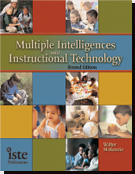"Once you start down the road of integrating MI into instruction, you make an implicit commitment to yourself to be honest, to be open to new possibilities, and to be willing to change." - Walter McKenzie
Technology from an educator's point of view |
"I want to share with you the possibilities for Dr. Howard Gardner's multiple intelligences (MI) theory as it relates to technology and instruction. These intelligences are each viable, distinct pathways to learning; ways of knowing which stand on their own two feet and yet act in consort with even greater power. They are not talents, gifts, aptitudes or learning styles. Talents, gifts and aptitudes each connote an ability above and beyond the realm of simple human understanding, such as the ability to play a musical instrument well or set new records in athletic competitions. Learning styles are fixed modes of understanding that a learner uses regardless of the instructional context. Intelligences are more than either of these. They are legitimate conduits of cognition that can be flexibly applied across the curriculum in varied contexts by all learners.
Although we each have all the intelligences, they are distributed uniquely in each of us. Because of this, there is a tendency to want to label learners by specific intelligences. Gardner is adamantly opposed to this. He sees his theory as a way to empower learners, not to diagnose deficits and prescribe remediation. Therefore, I avoid discussing “types” of learners and the suggestion that there are surefire types of instruction and technology that accommodate specific learner strengths. Analyzing instruction by intelligences is one thing, but once done we need to rebuild that instruction so that it is once again holistic when it is delivered in the classroom.
Through my presentations on multiple intelligences theory around the country, I have met teachers who are full of excitement and questions as we consider the implications of Gardner 's work. Many indicate that they are already very familiar with his theory, and that they are ready to learn ways to implement his work systematically in the classroom. I am always delighted to work with these dedicated people to help them explore the possibilities for instruction. I am often asked if there is one quick and easy way to accommodate the intelligences in the classroom. Indeed, there are books on the market today that try to capitalize on this desire for one neatly packaged, surefire way to realize the promise of multiple intelligences. Those who truly know Gardner 's work, though, know that to realize its full potential we have to dig deeper.
In writing this book I want to address this need expressed by teachers for concrete approaches to using MI and technology in the classroom. There is a huge void between Gardner 's vision and its successful implementation in instruction. There is no prepackaged MI program that will faithfully follow multiple intelligences theory, just as there is no psychometric instrument that will accurately measure these varied kinds of intelligence. Yes, there are people out there willing to sell such promises and products to you if you have the money, but stand firm by your convictions and don't be a soft sell!
It is my hope that this book will provide you with the structure you need to successfully begin implementing Gardner 's work in your classroom. You will discover all sorts of possibilities for bringing in technology and other materials to augment your instruction, and they will be your choices because you know what is appropriate and effective in your classroom. It is my hope that you will be empowered by the possibilities you discover!"
-Walter McKenzie
~lesson, unit and project examples and templates ~ideas for accommodating the intelligences online
|
http://surfaquarium.com/MI/book1.htm
Copyright©2017
No portion of this page may be cited, copied, repreinted or distributed without written permission


